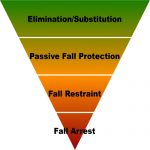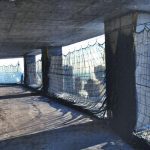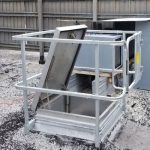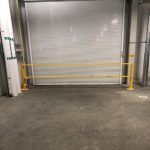Continued Discussion: Hierarchy of Fall Protection – Fall Prevention Systems
 As discussed in last month’s blog understanding the hierarchy of fall protection will help an employer and employees who are working at heights make their work environment as safe as possible. In this blog we will talk a little more about Fall Prevention Systems which is second on the hierarchy of fall protection. Fall Prevention Systems are second on the hierarchy because the first solution– Elimination- preventing access or removing the hazards is always the safest and best first solution. For instance, removing an air handler from the roof to the ground or replacing a ladder with a stairway are ways to eliminate the fall hazard. Ideally, the safest option to ensure worker safety is to completely eliminate the fall hazard. However, if this not possible a Fall Prevention System can be installed to create a barrier which is another way of eliminating the hazard.
As discussed in last month’s blog understanding the hierarchy of fall protection will help an employer and employees who are working at heights make their work environment as safe as possible. In this blog we will talk a little more about Fall Prevention Systems which is second on the hierarchy of fall protection. Fall Prevention Systems are second on the hierarchy because the first solution– Elimination- preventing access or removing the hazards is always the safest and best first solution. For instance, removing an air handler from the roof to the ground or replacing a ladder with a stairway are ways to eliminate the fall hazard. Ideally, the safest option to ensure worker safety is to completely eliminate the fall hazard. However, if this not possible a Fall Prevention System can be installed to create a barrier which is another way of eliminating the hazard.
Fall Prevention
 Fall Prevention Systems usually include guardrail systems, vertical netting systems, controlled access zones, and warnings lines. Fall Prevention Systems by definition create a barrier that eliminates the hazard and prevents the worker from falling. Again understating the work you are performing and where you are performing the work will help you determine the kind of Fall Prevention Systems that is needed on job site. Fall Prevention Systems like most Fall Prevention/Protection Systems apply for two industries- the Construction Industry and General Industry.
Fall Prevention Systems usually include guardrail systems, vertical netting systems, controlled access zones, and warnings lines. Fall Prevention Systems by definition create a barrier that eliminates the hazard and prevents the worker from falling. Again understating the work you are performing and where you are performing the work will help you determine the kind of Fall Prevention Systems that is needed on job site. Fall Prevention Systems like most Fall Prevention/Protection Systems apply for two industries- the Construction Industry and General Industry.
In the Construction Industry Fall Prevention Systems are usually a temporary solution. In most cases, the work being done is only temporary and when the work is completed the fall hazard no longer exist. Therefore netting systems and guardrail systems are most commonly seen in the Construction Industry and provide a barrier that eliminates a hazard while the work is being performed. Also, in some cases these Fall Prevention Systems can be moved on the construction site to where the next hazard exists to provide protection until the work is complete.
Fall Hazard
 When it comes to General industry a fall hazard usually presents a permanent problem that needs to be eliminated. Understanding where the work is being performed and the hazard that needs to be eliminated will allow companies to implement the best Fall Prevention System. Also understanding the New Walking Working Surface Regulations (OSHA 1910 Subpart D)- which will be discussed in another blog- an employer can come up with best solution. For example, if maintenance needs to be performed on piece of equipment such as an air handler which is 0-6 from the edge of the roof- permanent fall protection is required. One option for the employer is to install a guardrail system that protects the worker.
When it comes to General industry a fall hazard usually presents a permanent problem that needs to be eliminated. Understanding where the work is being performed and the hazard that needs to be eliminated will allow companies to implement the best Fall Prevention System. Also understanding the New Walking Working Surface Regulations (OSHA 1910 Subpart D)- which will be discussed in another blog- an employer can come up with best solution. For example, if maintenance needs to be performed on piece of equipment such as an air handler which is 0-6 from the edge of the roof- permanent fall protection is required. One option for the employer is to install a guardrail system that protects the worker.
 Loading docks are another example of a fall hazard in facilities that can use Fall Prevention Systems to eliminate the hazard by creating a barrier. A guardrail system can be installed that swings or lifts open when the loading dock is in use and closes when work is complete to prevent a fall- reference picture. Other Fall Prevention Systems include warning lines and controlled access zones which are used when specific areas need to be accessed for work and are also a cost saving method. Also hatch and ladder defenders can be used as part of Fall Prevention Systems to create barriers that prevent falls.
Loading docks are another example of a fall hazard in facilities that can use Fall Prevention Systems to eliminate the hazard by creating a barrier. A guardrail system can be installed that swings or lifts open when the loading dock is in use and closes when work is complete to prevent a fall- reference picture. Other Fall Prevention Systems include warning lines and controlled access zones which are used when specific areas need to be accessed for work and are also a cost saving method. Also hatch and ladder defenders can be used as part of Fall Prevention Systems to create barriers that prevent falls.
Eliminate the Hazard
Eliminating the fall hazard is first option on the hierarchy of fall protection because it is the most ideal application in any potential fall risk situation. If a hazard can be eliminated it no longer exist and the workers are safe. FallProof Systems can help your company to determine what the best Fall Prevention System is needed to protect your workers. Each fall risk and fall hazard is case by case basis and we can help in identifying what needs to be done to eliminate the hazard. This is why it is important for an employer to understand the work being performed and the regulations that are in place to protect workers from falling. FallProof Systems can help- by coming on site evaluating the potential fall risks, explaining the regulations, and ultimately having a conversation with everybody involved with the work to determine the best possible solution.

